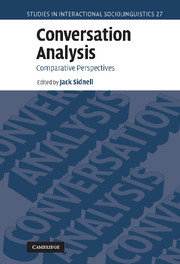Book contents
- Frontmatter
- Contents
- List of figures
- List of tables
- List of contributors
- Transcription conventions
- Part I Introduction
- Part II Repair and beyond
- 2 Repetition in the initiation of repair
- 3 A cross-linguistic investigation of the site of initiation in same-turn self-repair
- 4 Repairing reference
- Part III Aspects of response
- Part IV Action formation and sequencing
- Part V Conclusion
- Bibliography
- Index
3 - A cross-linguistic investigation of the site of initiation in same-turn self-repair
Published online by Cambridge University Press: 15 December 2009
- Frontmatter
- Contents
- List of figures
- List of tables
- List of contributors
- Transcription conventions
- Part I Introduction
- Part II Repair and beyond
- 2 Repetition in the initiation of repair
- 3 A cross-linguistic investigation of the site of initiation in same-turn self-repair
- 4 Repairing reference
- Part III Aspects of response
- Part IV Action formation and sequencing
- Part V Conclusion
- Bibliography
- Index
Summary
Introduction
Same-turn self-repair is the process by which speakers stop an utterance in progress and then abort, recast or redo that utterance. While same-turn self-repair has become a topic of great interest in the past decade, very little has been written on the question of where within a word speakers tend to initiate repair (the main exceptions being Schegloff 1979 and Jasperson 1998). And, to our knowledge, no work has been done on this question from a cross-linguistic perspective.
The goal of this paper is twofold: First, we explore existing proposals regarding where in words speakers initiate repair (what we will call the “site” of initiation) using data from our seven languages; and, second, we present and explain site of initiation data from those seven languages. Our findings suggest that there is a great deal of cross-linguistic variation with respect to favored sites of initiation but that most of the variation can be accounted for by a few simple interactional factors. This paper is the first study we are aware of which considers word length in explanations of self-repair data.
The current study is part of a larger project that has as its goal an understanding of the universal principles of self-repair and their language-specific manifestations. Prior studies have shown that the linguistic resources available to speakers of different languages shape the specific methods by which repair is accomplished (Fox et al. 1996; Wouk 2005; Fincke 1999; Egbert 2002; Sidnell 2007c; Karkainnen et al., 2007).
- Type
- Chapter
- Information
- Conversation AnalysisComparative Perspectives, pp. 60 - 103Publisher: Cambridge University PressPrint publication year: 2009
- 23
- Cited by

